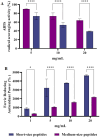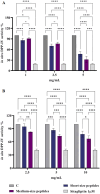Seaweed (G. gracilis) Protein Hydrolyzates: A Valuable Source of Short- and Medium-Chain Peptides with Multifunctional Properties
- PMID: 40673478
- PMCID: PMC12314915
- DOI: 10.1021/acs.jafc.5c03547
Seaweed (G. gracilis) Protein Hydrolyzates: A Valuable Source of Short- and Medium-Chain Peptides with Multifunctional Properties
Abstract
The sustainable valorization of infesting marine biomass offers opportunities to address environmental challenges and emerging nutritional needs. This study investigated the invasive red alga Gracilaria gracilis as a potential source of bioactive peptides with antihypertensive and antidiabetic properties. Protein hydrolyzates were generated via enzymatic digestion and fractionated by size exclusion chromatography. Peptidomics analysis using liquid chromatography coupled with high-resolution mass spectrometry identified 362 short-chain and 97 medium-chain peptides. Antioxidant effects were confirmed via diphenyl-2-picrylhydrazyl radical (DPPH), trolox equivalent antioxidant capacity (TEAC), and ferric reducing antioxidant power (FRAP) assays: at 20 mg/mL, short-chain peptides showed a TEAC of 60.8 ± 0.7% and a FRAP activity of 4638.7 ± 87.8%, significantly higher than the medium-chain fraction (36.1 ± 3.6% and 2180.6 ± 25.8%, respectively). Short-chain peptides also demonstrated stronger angiotensin-converting enzyme inhibition (19.53 ± 0.64% at 2.07 mg/mL) compared to medium-chain peptides (12.5 ± 0.42%). Conversely, medium-chain peptides exhibited superior dipeptidyl peptidase IV inhibition. Trans-epithelial transport experiments confirmed bioavailability, with 40 short peptides and 65 medium peptides detected in the basolateral compartment. These findings demonstrate the potential of converting invasive seaweeds into multifunctional ingredients for functional foods or nutraceuticals, supporting marine biotechnology and circular bioeconomy strategies for preventive healthcare and metabolic disease management.
Keywords: Caco-2 cell; algae; angiotensin-converting enzyme inhibitory properties; antioxidant properties; bioactive peptides; dipeptidyl-peptidase IV; intestinal trans-epithelial transport; liquid chromatography coupled to high-resolution mass spectrometry; peptidomics.
Figures






Similar articles
-
Potential of Marine Bacterial Metalloprotease A69 in the Preparation of Antarctic Krill Peptides with Multi-Bioactivities.Mar Drugs. 2025 May 24;23(6):226. doi: 10.3390/md23060226. Mar Drugs. 2025. PMID: 40559635 Free PMC article.
-
Microwave Irradiation Pre-Treatment as a Sustainable Method to Obtain Bioactive Hydrolysates from Chicken Feathers.Int J Mol Sci. 2025 Jun 30;26(13):6344. doi: 10.3390/ijms26136344. Int J Mol Sci. 2025. PMID: 40650122 Free PMC article.
-
Eco-sustainable production of bioactive peptides: Antioxidant and antihypertensive potential of Priacanthus hamrur fish skin waste hydrolysate using protamex enzyme.Int J Biol Macromol. 2025 Aug;320(Pt 4):146129. doi: 10.1016/j.ijbiomac.2025.146129. Epub 2025 Jul 17. Int J Biol Macromol. 2025. PMID: 40683504
-
The Black Book of Psychotropic Dosing and Monitoring.Psychopharmacol Bull. 2024 Jul 8;54(3):8-59. Psychopharmacol Bull. 2024. PMID: 38993656 Free PMC article. Review.
-
Dipeptidyl-peptidase (DPP)-4 inhibitors and glucagon-like peptide (GLP)-1 analogues for prevention or delay of type 2 diabetes mellitus and its associated complications in people at increased risk for the development of type 2 diabetes mellitus.Cochrane Database Syst Rev. 2017 May 10;5(5):CD012204. doi: 10.1002/14651858.CD012204.pub2. Cochrane Database Syst Rev. 2017. PMID: 28489279 Free PMC article.
References
-
- Ramu Ganesan A., Subramani K., Shanmugam M., Seedevi P., Park S., Alfarhan A. H., Rajagopal R., Balasubramanian B.. A Comparison of Nutritional Value of Underexploited Edible Seaweeds with Recommended Dietary Allowances. J. King Saud Univ. - Sci. 2020;32(1):1206–1211. doi: 10.1016/j.jksus.2019.11.009. - DOI
-
- Armeli Minicante S., Bongiorni L., De Lazzari A.. Bio-Based Products from Mediterranean Seaweeds: Italian Opportunities and Challenges for a Sustainable Blue Economy. Sustainability. 2022;14(9):5634. doi: 10.3390/su14095634. - DOI
-
- Mouedden R., Abdellaoui S., El Madani F., El Ouamari N., Slimani D., Kasmi K., Taibi M., Zahir I., Chaabane K.. Gracilaria Gracilis – A Review of Ecological Knowledge, Chemical Composition, Cultivation, and Applications. Ecol. Eng. Environ. Technol. 2024;25(1):276–287. doi: 10.12912/27197050/175506. - DOI
-
- Gioele C., Marilena S., Valbona A., Nunziacarla S., Andrea S., Antonio M. G. G.. Source of Agar: A Short Review. Curr. Org. Chem. 2017;21(5):380–386. doi: 10.2174/1385272820666161017164605. - DOI
MeSH terms
Substances
LinkOut - more resources
Full Text Sources
Miscellaneous

